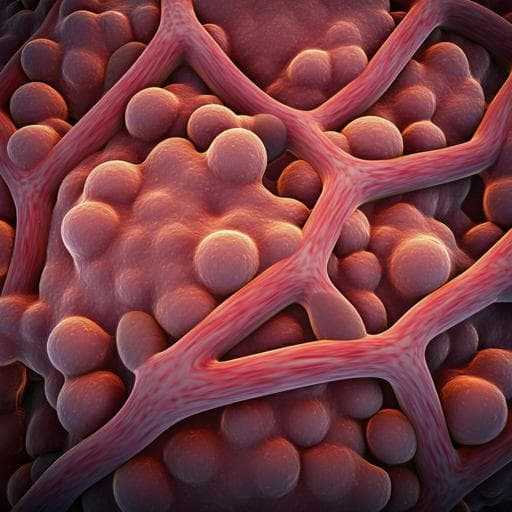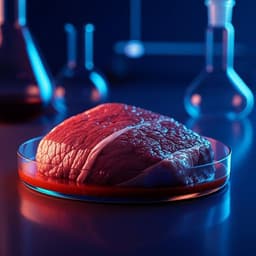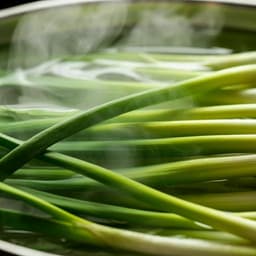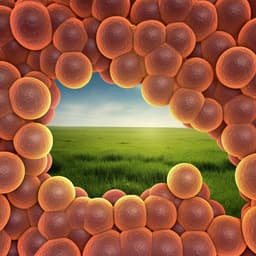
Food Science and Technology
An immortal porcine preadipocyte cell strain for efficient production of cell-cultured fat
Y. Cheng, P. Hong, et al.
Discover how adding adipose cells can revolutionize cell-cultured meat! The groundbreaking research by Yun-Mou Cheng, Peng-Cheng Hong, Ming-Mei Song, Hai-Ning Zhu, Jing Qin, Zeng-Di Zhang, Hao Chen, Xing-Zhou Ma, Meng-Yuan Tian, Wei-Yun Zhu, and Zan Huang reveals an immortalized porcine preadipocyte cell strain that enhances texture and aroma while being cost-effective in culture. Dive into this innovative study!
~3 min • Beginner • English
Introduction
The study addresses the need for reliable, highly adipogenic seed cells for cultured meat, focusing on fat to replicate meat’s flavor, juiciness, and texture. Conventional animal agriculture faces environmental challenges, and cellular agriculture offers a sustainable alternative. While most work emphasizes muscle, fat is critical for sensory qualities. Vegetable oils fail to match the lipid composition and structure of animal fat, supporting the use of in vitro fat cells. Primary preadipocytes lose proliferative and adipogenic capacity with passaging, limiting scalability. Previous immortalized adipogenic lines (mostly rodent and avian) and some porcine lines exist but generally show low adipogenic efficiency and have not been validated for cultured fat production. The research question is whether an immortalized porcine preadipocyte strain can be established that maintains long-term proliferative capacity with high adipogenic potential and is suitable for cost-effective, scalable cultured fat production in 2D and 3D systems, including co-culture with muscle cells.
Literature Review
Prior work established immortalized adipogenic lines such as rodent 3T3-L1 and avian lines (e.g., IPC1), as well as several porcine cell lines capable of >30 passages, but these often exhibit limited adipogenesis and have not been demonstrated for cultured fat production. Cultured meat approaches often supplement with plant oils, which differ in chain length, saturation, droplet morphology, and antioxidant behavior compared to animal fat. Edible bioscaffolds like alginate and textured soy protein (TSP) have been used for tissue structuring, and microcarriers in bioreactors enable upscaling. Co-culture of adipocytes and myocytes historically shows reciprocal inhibition, leading to separate differentiation and post-fabrication assembly, which increases time and cost. There is growing interest in immortalization strategies (overexpression of SV40T/TERT/E6/E7, knockout of tumor suppressors, or spontaneous immortalization), each carrying different regulatory and food safety implications. Reducing serum usage and minimizing regulated drugs in adipogenic cocktails are key for cost and safety in food applications.
Methodology
Cell line and culture: The immortalized swine preadipocyte single-cell–derived strain ISP-4 was selected from 108 SV40T-immortalized porcine adipocyte-derived strains via limiting dilution based on lipid accumulation capacity. Cells were cultured in DMEM with 10% FBS, penicillin/streptomycin; DMEM/F12 was compared for growth and adipogenesis. Growth was monitored over >40 passages.
Adipogenic differentiation protocols: Two methods were used. (1) Standard 4+4 protocol: 2 days recovery in growth medium (GM), 4 days adipogenic differentiation medium (ADM; insulin, T3, dexamethasone, IBMX, indomethacin, rosiglitazone, biotin, pantothenic acid, transferrin in GM), then 4 days adipogenic maintenance medium (AMM; insulin in GM). (2) 2x5 protocol: 10 days in AMM only with changes every other day. Serum level variation was tested (10% vs 2% FBS) in both 2D and 3D cultures.
2D characterization: Lipid accumulation assessed by BODIPY fluorescence and Oil Red O; adipose gene expression (FABP4, PLIN1, ADIPOQ) by RT-qPCR (ΔΔCt, 36B4 reference); protein markers by Western blot (PLIN1/GAPDH). Proliferation and adipogenesis were compared across passages (e.g., P10, P20, P30, P40).
3D alginate hydrogel culture: ISP-4 suspended at 1.25×10^7 cells/mL in 0.75% alginate; extruded into 50 mM CaCl2 to form microfibers; recovered 4 days in GM, then differentiated per protocols (4+4, 2x5, and 4+4 with 2% FBS). Structural assessment by confocal (BODIPY, Hoechst) maximum intensity projection and H&E staining; Ki67 assessed for proliferation; lipid area quantified via ImageJ; adipose genes by RT-qPCR.
Textured soy protein (TSP) scaffold: Wire-drawing peanut protein/TSP-like scaffolds were pre-soaked in GM, seeded using fibrin/thrombin cell embedding, and induced with 4+4; morphology and colonization assessed by H&E and visual inspection (color change, buoyancy).
Upscaled microcarrier culture: 3D TableTrix gelatin microcarriers (5 mg/mL) in 100 mL spinner flasks. Seeding 2.5×10^6 ISP-4; intermittent stirring for first 24 h then constant 40 rpm; 50% medium changes every 48 h. Cell counts from lysed carrier samples; comparison across passages (e.g., P10 vs P40). Post-expansion differentiation tested both after harvest into alginate and in situ on microcarriers using the 4+4 protocol; lipid staining/quantification and qPCR performed.
Co-culture and co-differentiation: ISP-4 with mouse myoblasts (C2C12) or porcine immortalized muscle satellite cells (PMSC). For C2C12: co-seed (1×10^5 ISP-4:3×10^5 C2C12) in GM, 48 h; 4 days ADM (2% FBS), 4 days AMM (2% FBS), then 2% horse serum (HS) AMM for myogenesis to day 12. For PMSC: co-seed (0.6×10^5 ISP-4:1.4×10^5 PMSC) in 12-well; 48 h ADM, 48 h AMM, then 96 h AMM with 2% HS. Assessment by brightfield, BODIPY, DAPI/Hoechst, immunofluorescence (DESMIN, MYL1), phalloidin staining, RT-qPCR for adipose (ADIPOQ, FABP4, PLIN1) and muscle genes (Myod1, Myog, Myh1), and DESMIN immunoblotting. Statistics by two-tailed unpaired Student’s t-test; data as mean ± SEM.
Additional assays: Oil Red O quantification at 500 nm; triglyceride assay (mg/g beads); Western blot (PLIN1, DESMIN, FLAG as appropriate, GAPDH, TUBULIN).
Key Findings
- ISP-4 exhibits stable proliferation and adipogenic capacity over >40 passages: growth rate not significantly decreased; lipid accumulation (BODIPY, Oil Red O) and adipose gene expression (FABP4, PLIN1) remained comparable across P10, P20, P30, P40 (significance indicated with p-values up to ****P ≤ 0.0001 in figures where applicable).
- DMEM supports faster growth and higher adipogenesis than DMEM/F12 for ISP-4 (Supplementary Figs. 2a–d).
- Cost- and safety-optimized differentiation: ISP-4 can differentiate using AMM-only 2x5 protocol (10 days), accumulating substantial lipids without IBMX/indomethacin/dexamethasone/rosiglitazone, though less than standard 4+4; insulin is required (no lipid accumulation without insulin).
- Serum reduction: In 2D, 2% FBS under 4+4 achieved lipid accumulation comparable to 10% FBS; in 3D alginate, 2% FBS in 4+4 reduced lipid accumulation and adipose gene expression compared with 10% FBS.
- 3D alginate differentiation: ISP-4 within alginate microfibers showed progressive lipid droplet formation during 4+4; quantified lipid area increased by ~100-fold from Day 0 to Day 8; adipose gene expression (FABP4, ADIPOQ, PLIN1) markedly upregulated at maturation. ISP-4 remained Ki67+ at Day 0 indicating proliferation in gel.
- Alternative differentiation regimes in 3D: 2x5 in alginate yielded less lipid and lower adipose gene expression than 4+4; cells formed clumps, suggesting continued proliferation during AMM-only differentiation.
- TSP scaffold: ISP-4-seeded TSP slices showed external cell layers with limited internal colonization and lower lipid accumulation compared to alginate, indicating need for protocol optimization.
- Upscaled spinner culture on edible microcarriers: ISP-4 colonized 3D TableTrix beads and expanded with a 40-fold increase in cell density over 6 days (log phase Days 2–5; stationary by Day 6). Expansion rate preserved at high passage (e.g., P40). Post-harvest cells differentiated in alginate to lipid levels similar to 2D-sourced cells (no significant difference).
- In situ microcarrier adipogenesis: Under 4+4, ISP-4 accumulated lipids directly on gelatin microcarriers, covering bead surfaces with mature adipocytes; lipid content (mg/g beads) and adipose gene upregulation confirmed; capability preserved at higher passage.
- Co-differentiation with muscle cells: ISP-4 co-cultured with C2C12 formed constructs with mature adipocytes interlaced with myotubes by Day 12. Adipose genes increased after ADM and further with 2% HS; muscle genes (Myod1, Myh1) peaked around Day 8, Myog increased through Day 12. With porcine PMSC, shortened ADM/AMM preserved myogenesis; by Day 8, mature adipocytes and muscle fibers coexisted; adipose/muscle gene expression and DESMIN protein confirmed differentiation.
- Scalability and cost/safety advantages: ISP-4 supports reduced-serum (2% FBS) differentiation in 2D, AMM-only differentiation (drug-sparing), upscaled expansion on edible carriers, and in situ differentiation, reducing handling and cost.
Discussion
The study demonstrates that ISP-4, an immortalized porcine preadipocyte clone, addresses key bottlenecks in cultured fat production: long-term expansion without loss of adipogenic potential, efficient differentiation under reduced-serum and drug-sparing conditions, compatibility with 3D edible scaffolds, and suitability for upscaled microcarrier bioprocesses. The ability to achieve adipogenesis with AMM-only mitigates food safety concerns associated with regulated pharmaceuticals in adipogenic cocktails, while successful 2% FBS differentiation in 2D suggests potential for cost reductions. Robust 3D adipogenesis with ~100-fold lipid increase and strong adipose marker induction shows that ISP-4 can form tissue-like fat within alginate; however, serum reduction in 3D impacted lipogenesis, highlighting context-specific metabolic needs. Upscaled spinner culture yielded a 40-fold increase over 6 days and enabled in situ adipogenesis on edible gelatin microcarriers, streamlining processing and reducing labor. Importantly, ISP-4 co-differentiated with myoblasts (C2C12 and porcine PMSC) into marble-like constructs, offering a route to integrated fat-muscle tissues without separate maturation steps, thereby potentially reducing time and costs. Collectively, these results substantiate ISP-4 as a practical seed cell for cultured fat and integrated meat constructs, providing a platform to optimize media, scaffolds, and bioprocessing strategies for food applications.
Conclusion
This work establishes ISP-4, an immortal porcine preadipocyte strain, as a highly adipogenic, scalable seed cell for cultured fat production. ISP-4 maintains adipogenic capacity beyond 40 passages, differentiates effectively in 2D and 3D (alginate) systems, tolerates reduced-serum conditions in 2D, and can undergo drug-sparing AMM-only differentiation. It expands efficiently in spinner flasks on edible gelatin microcarriers and supports in situ adipogenesis, reducing handling steps. ISP-4 also co-differentiates with myoblasts to form marble-like fat-muscle constructs. These advances provide cost, safety, and process benefits for cellular agriculture. Future research should prioritize spontaneously immortalized lines across species, creation of diverse single-cell–derived seed cell banks, optimization toward serum-free media, development of non–animal-derived edible microcarriers, adaptation to anchorage-independent growth for higher cell densities, and further validation of co-differentiation with porcine muscle cells in larger-scale systems.
Limitations
- Immortalization was achieved via lentiviral SV40T expression, potentially raising food safety concerns for consumption.
- Continued reliance on animal-derived components (e.g., FBS, gelatin-based microcarriers) was not fully eliminated.
- Production performance was not validated in larger-scale bioreactors; achieved cell densities (~1.8×10^6 cells/mL; 40-fold over 6 days) remain below commercial targets (~5×10^7 cells/mL).
Related Publications
Explore these studies to deepen your understanding of the subject.







